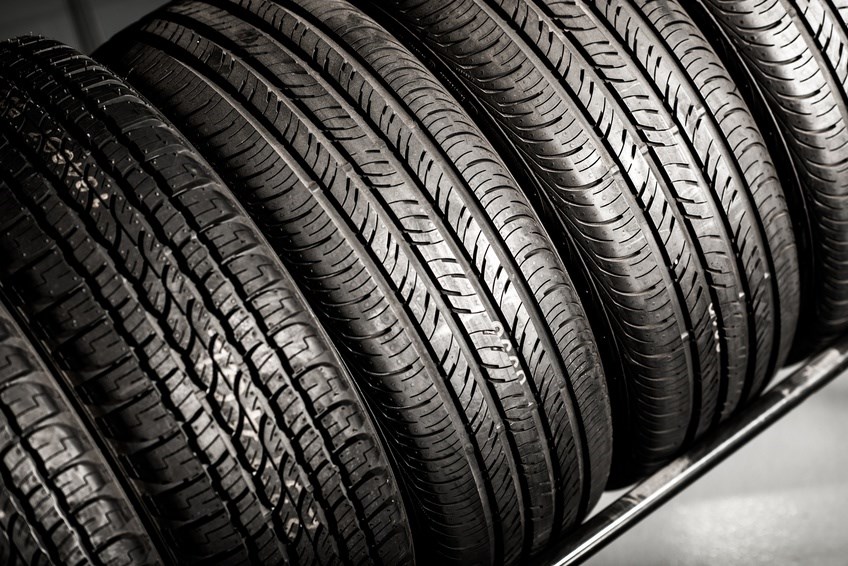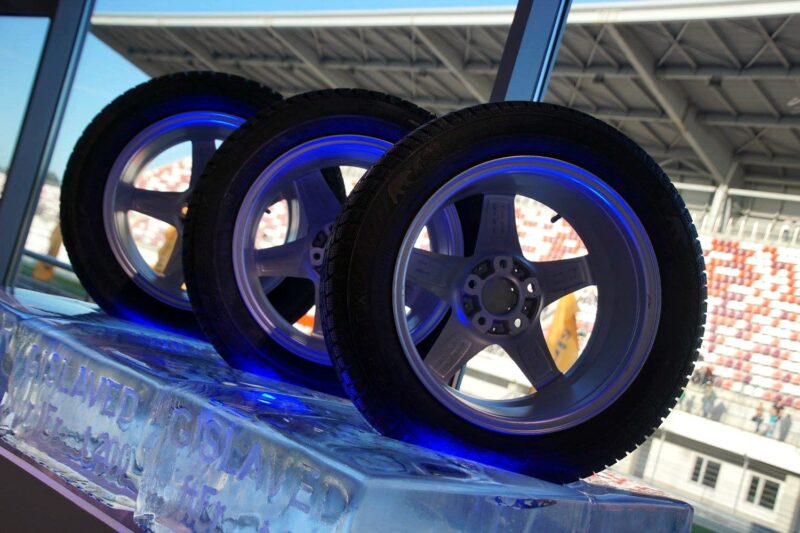
Misconception 1:
The tire must be inflated to the pressure indicated on the tire wall.
Fact: The tire sidewall is the maximum permissible inflation pressure (tire manufacturer’s instructions), not recommended by the manufacturer of the vehicle in which the tire is fitted. As the tire inflation pressure recommended by the vehicle manufacturer ensures that the tire’s performance at this pressure helps the vehicle’s optimal performance in terms of suspension, steering, stability and safety. The recommended front and rear wheel pressures may be equal or different depending on vehicle design and performance requirements. This value is recorded in the car’s owner’s manual, in the car drawer, or on the driver’s door pedestal.
Misconception 2: The
tread pattern is to increase the grip and traction of the tire on dry roads.
Fact: Racing car tires without tread are also designed to give maximum traction and traction on dry ground. The reason for the presence of the tread is to drain the water between the tire and the road for wet roads, as it allows water to pass through it outside the contact area and improves adhesion and thrust.
Misconception 3:
Performance tires wear out faster than regular tires due to the material used in their manufacture.
Fact: High performance tires may wear out faster than regular tires, but not because of the material used in their manufacture, as modern manufacturing techniques have made the tread life of the two types equal. Rapid wear is a result of the high-powered vehicle fitted with the high-performance tires, as well as the aggressive driving style of this type of vehicle. It is the high acceleration and strong brakes that lead to high tire wear.
Misconception 4:
Wide tires give better grip and greater traction to all season tires in the ground covered with a large layer of snow.
Fact: A wide tire floats on snow, and the pressure distribution over a wide area of contact does not allow the tire spurs to get deeper into the snow on the road to increase traction. Conversely, thinner tires (not wide) do a better job.
Misconception 5:
If a tire with a larger diameter is installed than the original tire installed on the car, the tire will wear less and be safer.
Fact: The car is designed so that the tire and the car work together to get optimum performance. Therefore, installing a tire with a larger diameter will not only make the reading of the speed number inaccurate, but it will affect making the car less performing and will affect the car’s stability and reduce the ability to control the car. Usually, a larger tire will be more expensive, and installing a larger tire will not produce any significant additional benefit.
Misconception 6:
Do not rotate the tires from side to side but only the front tires can be installed in the back and the rear tires can only be installed in the front.
Fact: radial tires can be changed from side to side. The change from front to back applies to tires with bias ply. The tires are rotated every 6000 to 8000 miles (9,000 km to 13,000 km) to make uniform wear of all tires in the car.
In the case if the tires are unidirectional, the front-to-rear rotation can be on the same side of the vehicle just to maintain the direction of rotation of the tires. Most one-way tires can also be moved from side to side if the rim is removed and remounted; Except in the case of tires on asymmetric rims, which is a rare exception.
Misconception 7:
Adjusting the angle of the calf does not affect the rate of fuel consumption.
Fact: Tires that do not turn in the direction of travel have sideways traction on the road surface equivalent to several meters for every kilometer traveled. This will not only increase the rolling resistance of the tire (and thus increase the overall belt resistance), but also lead to rapid tire wear. Not adjusting the toe-in has the greatest effect on tire wear, although it is the easiest to correct. The camber angle (the vertical tilt of the wheel), the caster angle (the forward axle tilt), and the axle alignment (which is the second cause of irregular tire wear should also be checked and adjusted). Failure to align the trailer with the locomotive leads to the wear of the locomotive’s tires, and for this reason, the parallelism of the trailer axes must be checked and adjusted as well.
Misconception 8:
Tires scattered on the road are retreads.
Fact: Drivers believe the spatter is the result of the adhesive solution for retreaded tyres. This is what prompted many states in America to study the issue to put in place a law that prohibits the use of retreaded tires in vehicles traveling on highways. But what the study found was surprising. A study conducted in 1999 showed that the scattered residues of tires on the road were a large amount of passenger car tires, despite the absence of retreaded tires for passenger cars. After studying truck tires, the study concluded that new tires have this phenomenon at the same rate as retreaded tires under the same operating conditions. Failure to adjust the tire pressure (20% pressure drop below the recommended pressure, the tire is considered deflated at the discretion of the tire manufacturers), or overloading makes the tires eligible for this phenomenon. The effect of low pressure and overloading leads to greater dent in the tire wall at the bottom of the tire, When walking, the wall is bent (at the bottom of the tire) and the wall is straightened (at the top of the tire). Repeated bending and straightening of the tire wall as a result of rotation leads to the generation of heat. This heat increases by increasing the amount of wall bending (low pressure and high load). The part in contact with the road cools as a result of heat transfer from the tire to the road, and the interior part cools as a result of the tire’s contact with the rim. As for the part between the two, its temperature rises and leads to the melting of rubber and turning it into a liquid state. When braking or acceleration occurs, the tire tread separates from the rest of the tire in the form of a strip. When trying to change course and with lateral forces, the tread breaks off in a ring. Helps in the occurrence of this phenomenon in trucks is the difference in the size and inflation of tires for double tires on the same axle, which leads to an increase in the load on one wheel of the two and increases the heat generated by it. As for the part between the two, its temperature rises and leads to the melting of the rubber and turning it into a liquid state. When braking or acceleration occurs, the tire tread is separated from the rest of the tire in the form of a strip, and when trying to change the track and with the presence of lateral forces, the tire tread is separated in the form of a ring. Helps in the occurrence of this phenomenon in trucks is the difference in the size and inflation of tires for double tires on the same axle, which leads to an increase in the load on one wheel of the two and increases the heat generated by it. As for the part between the two, its temperature rises and leads to the melting of the rubber and turning it into a liquid state. When braking or acceleration occurs, the tire tread is separated from the rest of the tire in the form of a strip, and when trying to change the track and with the presence of lateral forces, the tire tread is separated in the form of a ring. Helps in the occurrence of this phenomenon in trucks is the difference in the size and inflation of tires for double tires on the same axle, which leads to an increase in the load on one wheel of the two and increases the heat generated by it.
Misconception 9:
The tire must be inflated less than the recommended pressure in the summer because the air temperature is high, which will lead to high tire pressure as a result of the heat from the atmosphere.
The truth: This was not mentioned in the recommended tire inflation pressure from car manufacturers, as what is written in the car owner’s booklet or the data plate attached to the door post indicates that only one number was mentioned for the amount of pressure in the front tires and one number for the amount of pressure in the rear tires was not mentioned Air temperature in summer or winter. Rather, it was mentioned with those numbers that the tire pressure should be measured while the tire is cold, since air is considered a gas, it expands with heat and contracts with cold, and since the space in which the air (inside the tire) is closed, expansion and contraction leads to an increase and decrease in tire pressure (changes Tire pressure of 1 psi with each change of 5 degrees Celsius), if the weather is hot, the pressure will be high in the tire due to the outside temperature, so when resetting it will need less air to reach the required pressure.
Misconception 10:
When buying 2 new tires, it is preferable to put it in the front axle, especially for front wheel drive cars, to increase traction.
Fact: It is best to buy 4 new tires so that they are all replaced at the same time. But in the case of purchasing 2 new tires, it is recommended to install the tires on the rear axle for front wheel drive, rear wheel drive or four-wheel drive cars. When entering a corner, a vehicle with the new tires on the front axle is prone to oversteer, especially when the road is wet.
There are no reviews yet. Be the first one to write one.

